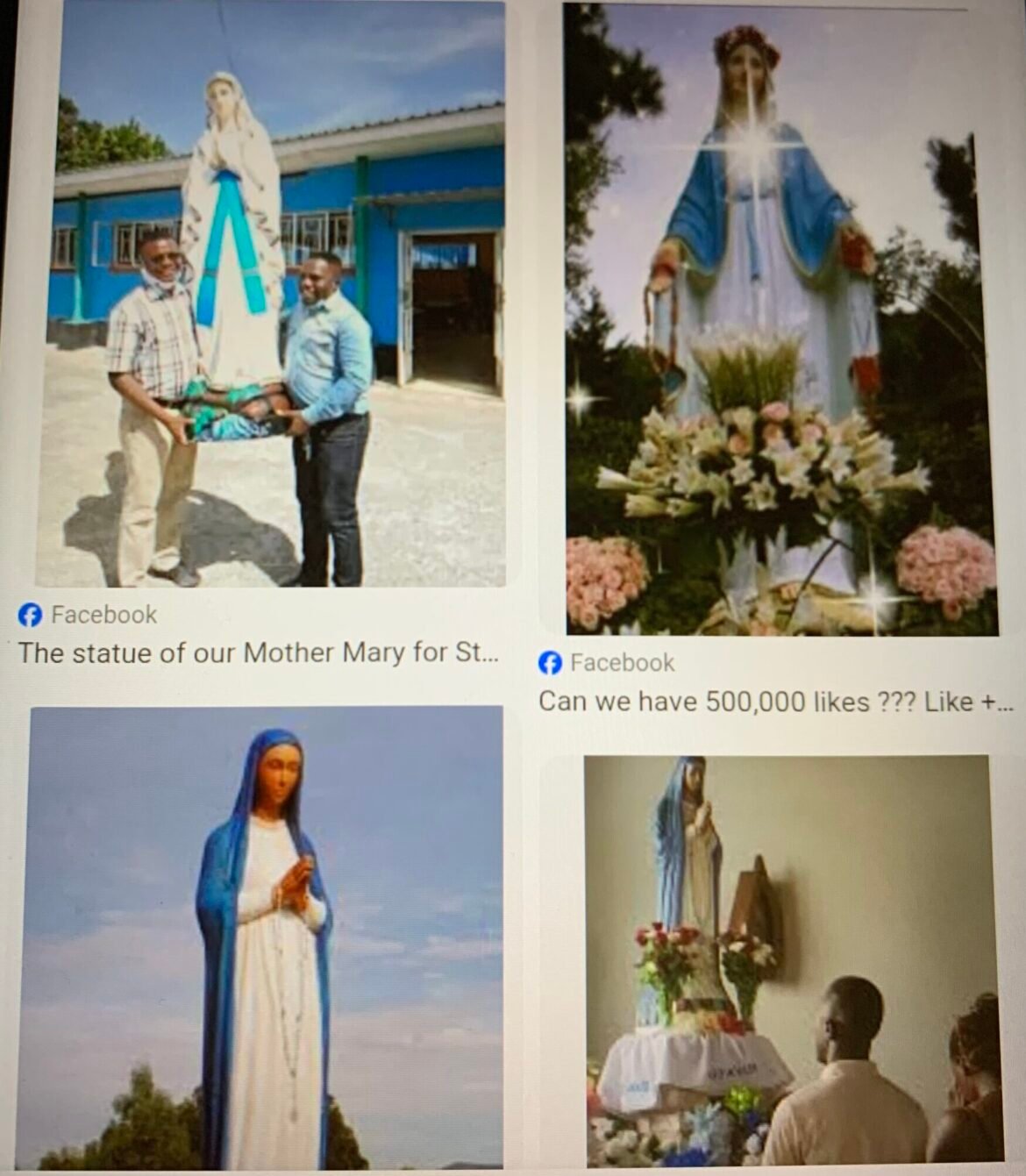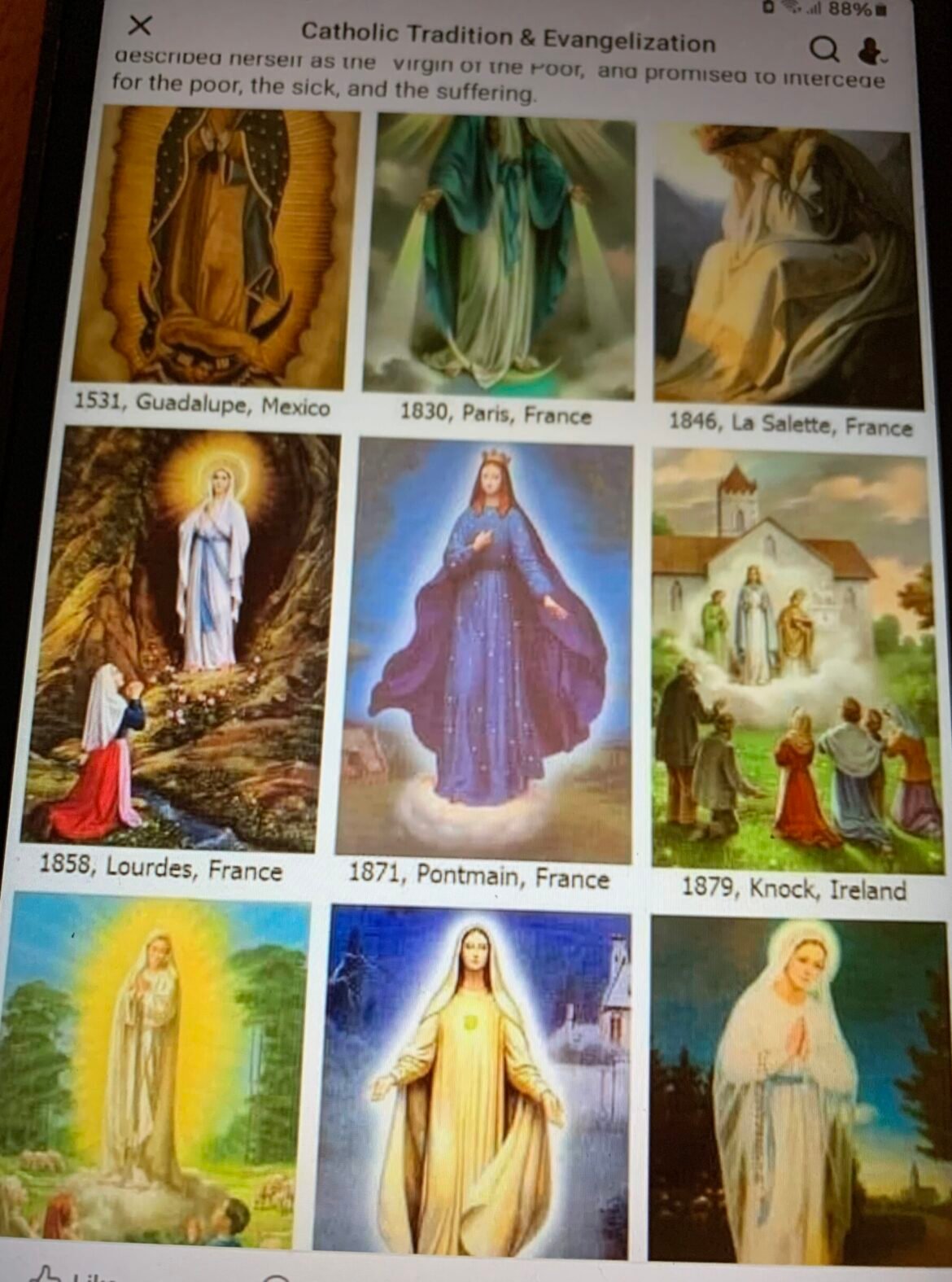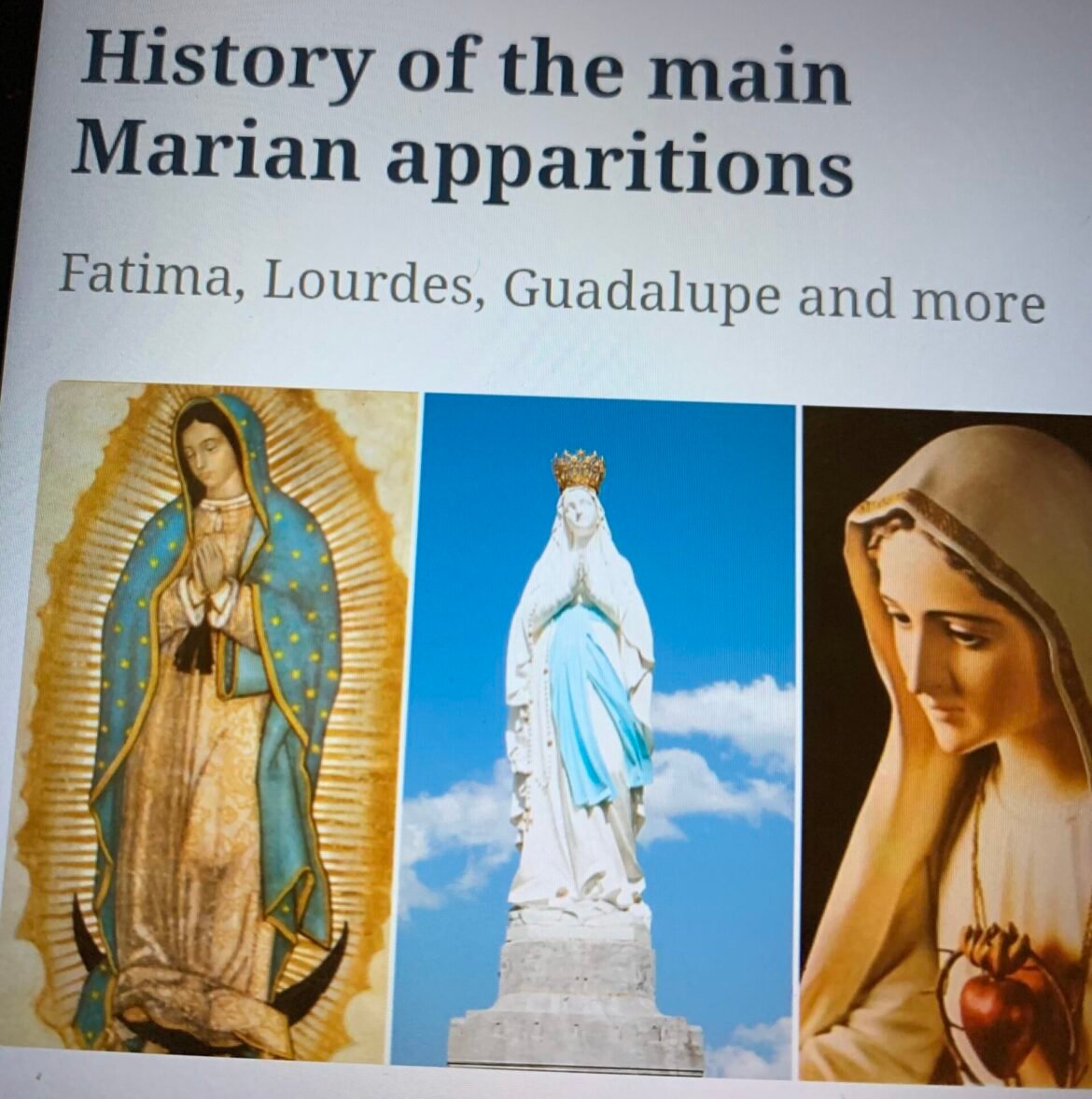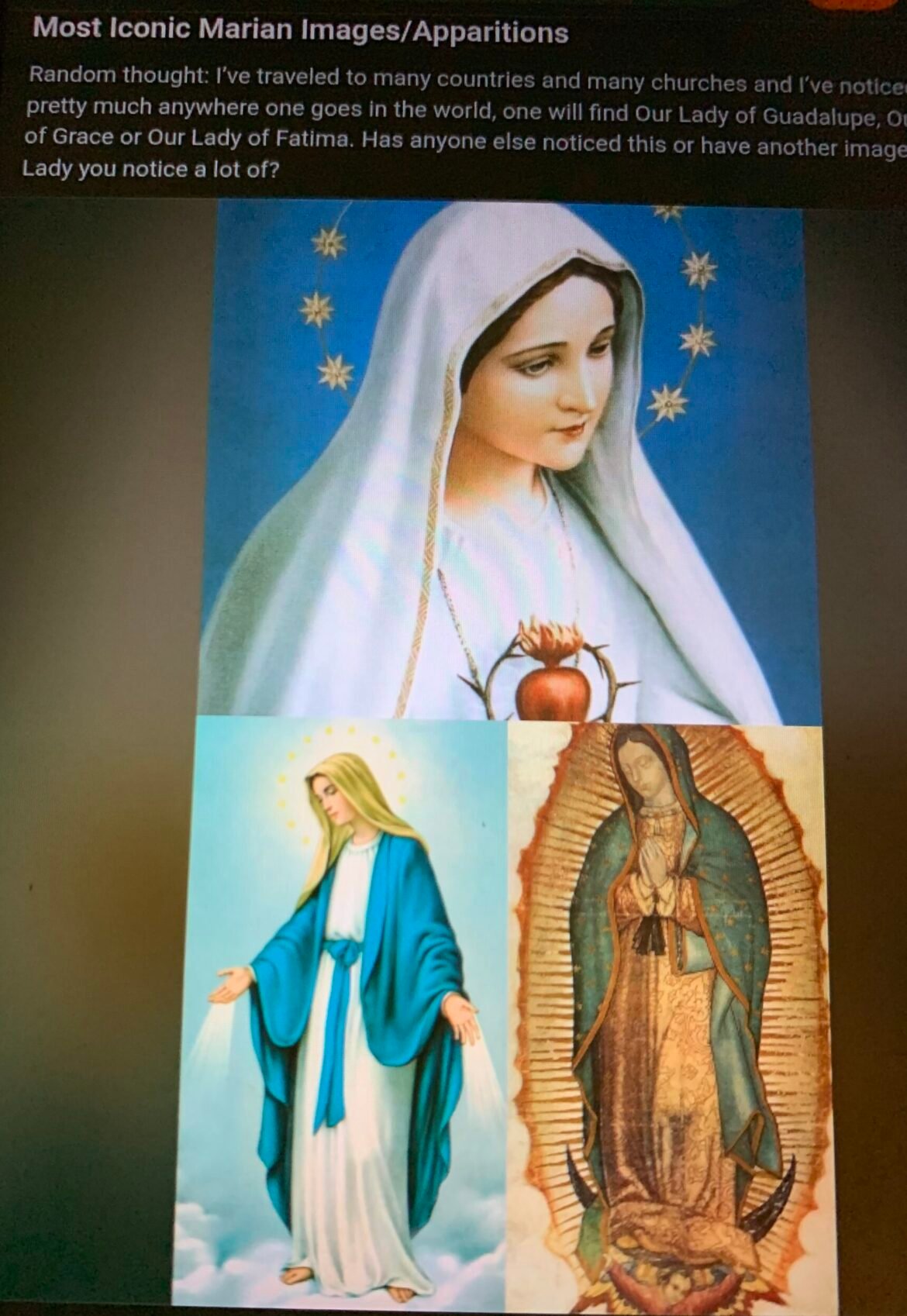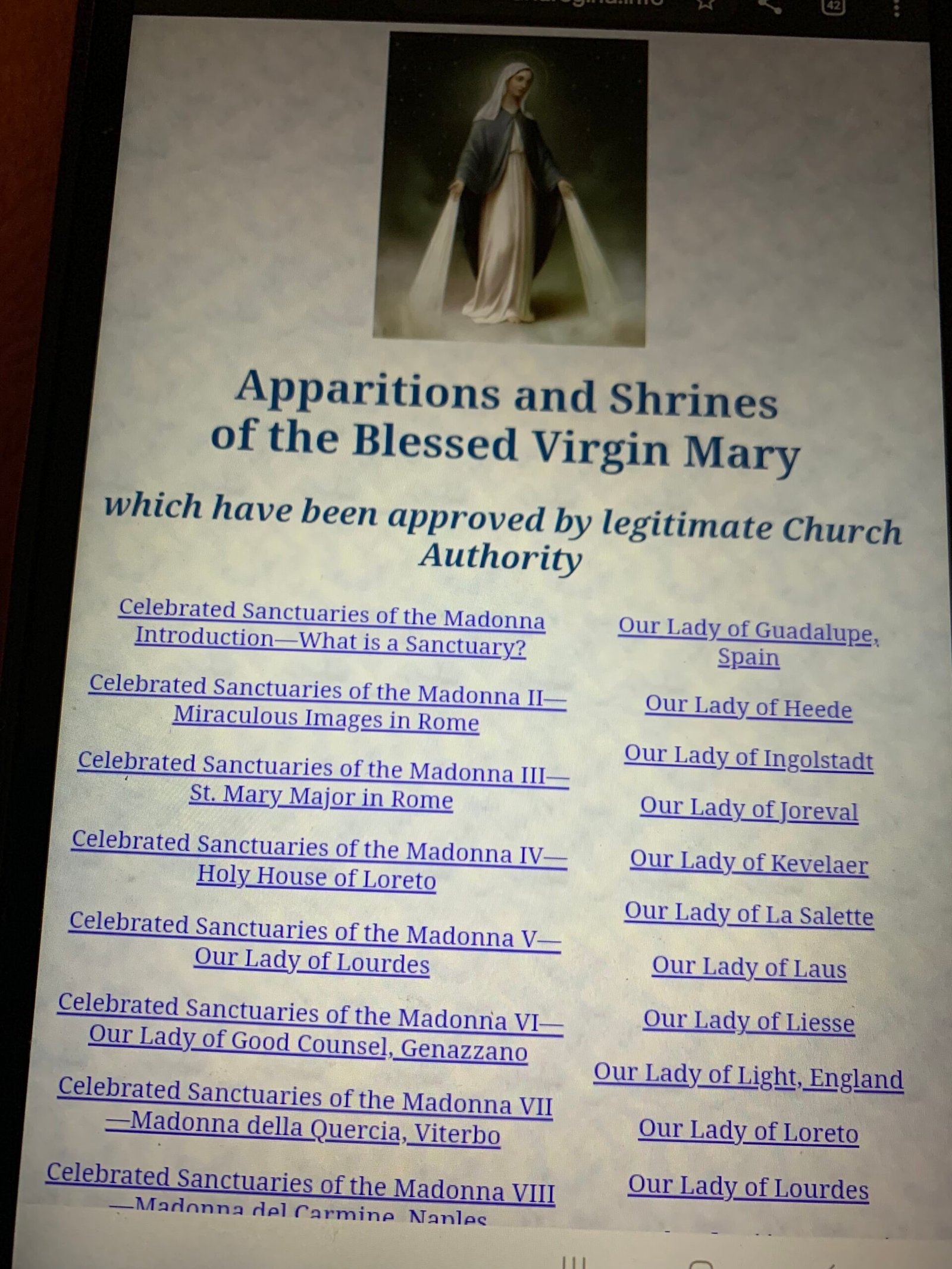- PART 1: Antichrists revealed by our Jesus Christ – Linus the first antichrist (2Timothy 4:21)
- Part 2: Antichrists revealed by Jesus Christ – Idols Worshipping
- PART 3: Antichrists revealed by Jesus Christ – Deceptions of the antichrists
- PART 4: Antichrists revealed by our Lord Jesus Christ – How the Antichrist made dead people into sainthood
- PART 5: Antichrists revealed by Jesus Christ – Opposing spirits of the antichrists
- PART 6: The Antichrists revealed by Jesus Christ – False teachings of the antichrists
- PART 7: Antichrists revealed by Christ – Enmity of the antichrists towards Christ
- PART 8: Antichrist revealed by Jesus Christ – Falsehood and web of lies
- PART 9: Antichrists revealed by Jesus Christ – Mary mother of the Roman Catholic Church
- PART 10: Antichrists revealed by Jesus Christ – John Paul 11 and the Virgin Mary
- PART 11: Antichrists revealed by Jesus Christ – Wrong teachings of the antichrists
- PART 12: Antichrists revealed by Jesus Christ – The making of Images by the Antichrist
- PART 13: Antichrists revealed by Jesus Christ – Idolising images by the antichrists
- PART 14: Antichrists revealed by Christ – Feasts of the antichrists
- PART 15: Antichrists revealed by Jesus Christ- The false doctrine of the Papacy from the mouths of the Roman catholic churches worldwide
- PART 16: Antichrists Revealed by Jesus Christ – Disobedience of the antichrists against Christ
- PART 17: Antichrists revealed – Delibrate rebellion of the antichrist towards Christ
- PART 18: Antichrists Revealed by Christ – Making of Mary queen of heaven by the antichrists
- PART 19: Antichrists revealed by our Lord Jesus Christ Himself
- PART 20: Antichrists revealed by Jesus Christ – Making of images on God’s altars
- PART 21: Antichrists revealed by Christ – Fales doctrines of the antichrists
- PART 22: Antichrists revealed by Jesus Christ – False miracles of the Antichrists
- PART 23: Antichrists Revealed by Jesus Christ – The Secret Finances of the Vatican Economy
- PART 24 – Antichrists revealed by Jesus Christ – Going against Christ about images
- The queen ship of Mary -by the antichrists
- Vicarious Fiii Dei – The Number 666
- The relics of Mary’s veil – according to the antichrists
- The Antichrists or line of Popes dead or alive
- The Antichrist taught the Roman catholic churches the celebration of Ash Wednesday
- Biblical Truth: Jesus Christ Did Not Found the Roman Catholic Church
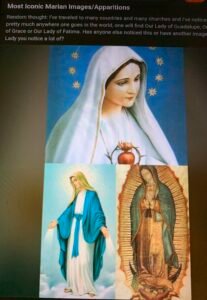
Positive judgment
The apparitions in this category have been judged to be “worthy of belief”.
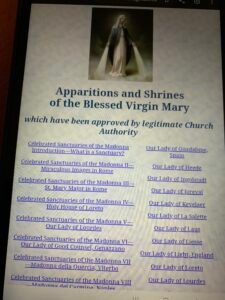
Approved, with widespread veneration endorsed by the Holy See
A distinction is sometimes made between apparitions that are “Vatican approved” and those that are not. However, by the norms of Normae Congregationis, the only formal mechanisms for Holy See approval of an apparition would be the popeapproving an apparition that had occurred in the Diocese of Rome, or the pope approving an apparition against the will of the local bishop, neither of which has happened to date. Even in cases in which the Congregation for the Doctrine of the Faith cooperates with an investigation that yields a positive result, the consequent approval derives its authority from the local bishop, not from the Holy See.]Because approval by the Holy See can therefore only be claimed based on informal indicators of endorsement, lists of “Vatican-approved Marian apparitions” vary widely depending on the criteria used.] The criterion used here is that the Holy See must have approved the widespread veneration of the apparition by inscribing it on a liturgical calendar besides that of the particular diocese in which the apparition occurred.
| Associated Marian titles | Years | Location | Seers | Approval | Feast day | |
|---|---|---|---|---|---|---|
| Our Lady of Guadalupe | 1531 | Juan Diego Cuauhtlatoatzin Juan Bernardino |
1555[11] | December 12 in the General Roman Calendar | ||
| Juan Diego, an Aztec who had recently converted to the Catholic faith, saw an apparition of Mary early in the morning on December 9, 1531, during which Mary asked that a church be built in the site of the apparition. The local bishop did not believe his story. In response, during another appearance to Juan Diego three days later, after also appearing to Diego’s sick uncle Juan Bernardino, Our Lady imprinted an image of herself on Juan Diego’s cloak (tilma). The cloak is on display at the Basilica of Our Lady of Guadalupe in Mexico City. Over the years, Our Lady of Guadalupe became a symbol of the Catholic faith in Mexico and the Mexican diaspora. | ||||||
| Our Lady of the Miraculous Medal Our Lady of Graces |
1830 | Catherine Labouré | 1 Archbishop Hyacinthe-Louis de Quélen Archdiocese of Paris |
November 27 in the Roman Calendar for Venezuela and the Vincentian orders[citation needed] | ||
| Catherine, a novice at the Daughters of Charity of Saint Vincent de Paul, reported that Mary appeared to her one night in the convent chapel and asked that a specific medallion be made, promising that “all who wear this medal will receive great graces.” The medal eventually produced is most commonly known as the Miraculous Medal due to the many miracles that were connected with it. The front of the medal displays a picture of Mary as Catherine described her. The design on the reverse includes the letter M and a cross. | ||||||
| Our Lady of La Salette | 1846 | Mélanie Calvat Maximin Giraud |
September 19, 1851[15][16] Bishop Philibert de Bruillard [fr; pl] Diocese of Grenoble |
September 19 in the Roman Calendar for France[17] | ||
| Two shepherd children reported seeing an apparition of Mary, who was weeping because of disrespect shown to the Lord’s Day and to the Lord’s name. She entrusted one secret to each of the two children, which they wrote down and delivered to Pope Pius IX. | ||||||
| Our Lady of Lourdes The Immaculate Conception |
1858 | Bernadette Soubirous | January 18, 1862 Bishop Bertrand-Sévère Laurence ] Diocese of Tarbes |
February 11 in the General Roman Calendar | ||
| A 14-year-old shepherd girl named Bernadette Soubirous reported seeing Mary appear to her while she was out gathering firewood in the countryside. Mary identified herself as “the Immaculate Conception” and told Bernadette of the location of a spring, promising miraculous healings from its waters. Since 1862, more than sixty medical cures associated with Lourdes have been certified as “miraculous” by the Catholic Church, which established its own Medical Bureau in 1883 to review and evaluate claims of cures. An independent study of cures published during 2012 concluded that some of the cures were “currently beyond our ken but still impressive, incredibly effective, and awaiting a scientific explanation.” | ||||||
| Our Lady of Knock | 1879 | Group of 15 people | 1879[22] Archbishop John MacHale Archdiocese of Tuam |
August 17 in the Roman Calendar for Ireland[23] | ||
| On August 21, 1879, a group of 15 men, women, and children, ranging in age from 5 to 75, reported seeing an apparition behind their church, against the back wall, of an altar with a lamb on it (understood to represent Jesus), surrounded by a multitude of angels. Off to the side in prayer stood Mary, Joseph, and St. John (with St. John dressed as a bishop). Because Mary was among those seen, the apparition is classified as Marian, although the simultaneous appearance of Jesus, Mary, Joseph, John, and numerous angels makes it unique among this category. A further distinctive characteristic is that this apparition was silent: no verbal messages were given. The apparition lasted for an hour and a half. | ||||||
| Our Lady of Fátima Our Lady of the Rosary The Immaculate Heart of Mary |
1917 | Lúcia Santos Jacinta Marto Francisco Marto |
October 13, 1930 Bishop José Alves Correia da Silva Diocese of Leiria |
May 13 in the General Roman Calendar | ||
| Three shepherd children reported seeing apparitions of an angel (who identified himself as the Guardian Angel of Portugal) followed by apparitions of Mary. Mary revealed to the children three secrets: first, the reality of hell and the means of saving people from it through personal sacrificesand Acts of reparation; second, a prediction of future upheavals (beginning with World War II), the spiritual means of ending them (a Consecration of Russia and Communions of reparation on First Saturdays), and a prediction of an eventual “triumph of the Immaculate Heart of Mary”; third, an obscure vision of future persecution of the Catholic Church. The apparitions culminated with the Miracle of the Sun, an astronomical phenomenon witnessed by a crowd of approximately 70,000 people, and even by others located miles away.[27] All nine popes since the apparitions – Benedict XV, Pius XI, Pius XII, John XXIII, Paul VI, John Paul I, John Paul II, Benedict XVI and Francis – have indicated their belief in the authenticity of the apparitions. Pope John Paul II credited Our Lady of Fátima with saving his life after he was shot in Rome on May 13 feast day of the apparition in 1981, and donated the bullet that wounded him to the Sanctuary of Our Lady of Fátima. In 1925, eight years after the Fátima events, Lúcia, then Sister Lúcia, reported another set of related apparitions, which became known as the Pontevedra apparitions. | ||||||
Approved
Below is a list of additional apparitions which have been approved by the local ordinary (i.e. the bishop assigned to the area in which the events allegedly occurred).
| Associated Marian titles | Years | Location | Seers | Approval | ||
|---|---|---|---|---|---|---|
| Our Lady of the Good Event | 1594–1634 | Mariana de Jesus Torres | 1611[30] Bishop Salvador Ribera Avalos Diocese of Quito |
|||
| A religious sister, Mother Mariana de Jesus Torres, reported that the Virgin Mary appeared to her at the Conceptionist Convent in Quito, Ecuador, under the title “Nuestra Señora del Buen Suceso”. According to Mother Mariana, Mary requested that a statue be made in her likeness and made several predictions, saying that the church and the world would enter into a period of crisis beginning in the mid-20th century, and that this period would be followed by a complete restoration. Although the phrase “Good Event” in the apparition title is also understood to refer to this prophesied restoration, the phrase, properly speaking, refers to the Purification of Mary and the Presentation of Jesus. | ||||||
| Our Lady of the Hens | 1609 | 11 different people | August 1786 | |||
| Despite the first apparition is dated back to the 16th century, the Madonna of the Hens is said to have performed eight miracles in the years 1609–1610. It all began when a cripple, who had fallen asleep in front of a dressing room belonging to the ancient parish of San Felice, where the table found by the hens was kept, saw the Madonna in his sleep; she invited him to get up and throw away his crutches because he was healed. The evident miracle attracted general attention to the small oratory, and in a very short time there were new healings: between 1609 and 1610 there were seven other miracles that confirmed in the faithful the devotion to the ‘Madonna of the Hens’ in and out of the region.It was then decided the building of a more worthy church to welcome the faithful, and in 1610 Msgr. Lunadoro, bishop of Nocera de’ Pagani, tells us that “thanks to the help of the devout people, who give large alms, a much more capable church is begun” to be built in the place where the hens had found the table, and Msgr. Stefano de Vicari, in his pastoral visit made in 1615, speaks of a ‘newly built church’ (Latin: ecclesia noviter erecta), namely the Shrine of Our Lady of the Hens.In August 1786 the diocesan bishop, Msgr. Benedetto dei Monti Sanfelice, published a decree with which the chapter of Saint Peter in the Vatican decided to solemnly crown the ‘Madonna delle Galline’ in gratitude for the protection of Mary to the population. The coronation ceremony took place in 1787. | ||||||
| Our Lady of Laus | 1664–1718 | Benoîte Rencurel | May 4, 2008 Bishop Jean-Michel Di Falco [] Diocese of Gap and Embrun |
|||
| Beginning in 1664, a young shepherdess reported seeing multiple visions of Mary, who said, “I have asked my Son for this place for the conversion of sinners and He has granted it to me.” Mary charged Benoîte to prepare sinners for the Sacrament of Penance, a vocation for which she received the gift of reading soulsMary asked for a sanctuary to be built, and foretold that it would last until the end of the world, emerging from obscurity and becoming well-known shortly before the onset of the endtimes. Benoîte continued to receive apparitions until her death in 1718. The local archbishop at the time approved the public veneration of the initial apparitions in 1665, but the apparitions themselves were not approved until almost four centuries later. | ||||||
| Our Lady of Champion | 1859 | Adele Brise | December 8, 2010 Bishop David L. Ricken Diocese of Green Bay |
|||
| In Robinsonville (now called Champion), Wisconsin, a young Belgian immigrant woman named Adele Brise was walking through a wooded area when she saw a beautiful woman standing between a maple and a hemlock tree. She saw the lady again on her way to Mass, and walked past her again. After Mass she told her priest about the apparition, and he told her to ask the Lady “In God’s name, who are you and what do you want of me?” When Adele walked past the spot again, the Lady was there, and Adele asked what she was told by the priest. The Lady replied, “I am the Queen of Heaven who prays for the conversion of sinners.” She gave Adele the mission to pray for sinners and teach the children of the area their Catechism, with the assurance, “Go and fear nothing, I will help you.” Soon after, Adele’s father built a small chapel between the trees, and later two more churches were built on the spot before the present brick church, built in 1942. Our Lady of Champion is the first approved apparition in the United States. In April 2023, the National Shrine of Our Lady of Good Help announced its official name change to The National Shrine of Our Lady of Champion. | ||||||
| Our Lady of Pontmain Our Lady of Hope |
1871 | Eùgene Barbadette Joseph Barbadette Jeanne-Marie Lebossé Françoise Richer |
February 2, 1872 Bishop Casimir Wicart ] Diocese of Laval |
|||
| At the height of the Franco-Prussian War, Pontmain, a hamlet of about 500 inhabitants, found itself between the oncoming Prussian army and the city of Laval. While two boys, Joseph and Eugène, aged ten and twelve, were helping their father in the barn, Eugène saw in the night sky an apparition of a beautiful woman smiling at him; she was wearing a blue gown covered with golden stars, and a black veil under a golden crown. Joseph came to look and could see the lady as well. As a crowd gathered, two girls, Françoise Richer and Jeanne-Marie Lebosse, ages nine and eleven, reported seeing Mary as well, and described her in the same way. None of the adults, however, could see Mary, but only saw three stars forming a triangle. The crowd began praying the Rosary. The children saw a banner unfurl beneath the Lady with a message: “But pray, my children. God will hear you in time. My Son allows Himself to be touched.” The apparition lasted about three hours. It was later discovered that the advance of the Prussian troops was halted at the same time that the apparition began; the general reported that the advance was blocked by a “Madonna”. | ||||||
| Our Lady of Gietrzwałd | 1877 | Stanisława Samulowska Justyna Szafryńska |
September 1, 1977 Bishop Józef Drzazga Diocese of Warmia |
|||
| A 13-year-old girl named Justyna Szafryńska reported that, while praying the Angelus on June 27, 1877, she saw a woman seated on a gold throne near a maple tree, accompanied by an angel. The following day, she saw another apparition, this time also with the Christ child. Three days after the first event, both she and 12-year-old Barbara Samulowska saw Mary, and Justyna asked: “What do you want, Holy Mary?” Mary answered in the local Polish dialect, “I want you to pray the Rosary daily.” During the apparition the next day, Justyna asked, “Who are You?” and Mary replied, “I am the Blessed Virgin Mary of Immaculate Conception. In the coming days, Mary promised that fervent prayer would be able to end the persecutions of Catholic Poles that had occurred under Kulturkampf. The apparitions continued for three months. On September 8, about a week before the apparitions ended, Mary blessed a spring of water, from which pilgrims have subsequently reported healings. Our Lady of Gietrzwałd is the only approved Marian apparition in Poland. | ||||||
| Our Lady of Tears | 1930 | Amália de Jesus Flagelado | March 8, 1931 Bishop Francisco de Campos Barreto ] Archdiocese of Campinas |
|||
| On November 8, 1929, a friend of Sister Amalia came to her to ask for prayers for his seriously ill wife. The nun then went to the chapel of the Institute of the Missionary Sisters of Jesus Crucifiedto pray in this intention, when suddenly Jesus appeared to her and said that she should ask him for this grace through the tears of her mother Mary, teaching her a prayer and assuring her that nothing would be denied her if the request was made in the name of his mother’s tears. He also stated that Maria would visit Amália soon.[48] On March 8, 1930, she was praying in the same place when the Virgin appeared to her. Maria was dressed in a purple tunic, a dark blue mantle, a white veil that stretched from her head to her chest and in her hands she held a rosary of glittering pearls. Maria then asked Amália to propagate the rosary, calling it “Crown of Tears”. She also stated that she would bestow graces on those who would pray it with devotion.[49] On April 8 of the same year, Maria appeared again to Amália, indicating a medal that should be used by her devotees so that they could obtain her protection and miracles. | ||||||
| Our Lady of Beauraing Virgin of the Golden Heart |
1932–1933 | Andree Degeimbre Gilberte Degeimbre Albert Voisin Fernande Voisin Gilberte Voisin |
July 2, 1949 Bishop André-Marie Charueb] Diocese of Namur |
|||
| Five children, ages 9 to 15, reported seeing 33 apparitions of Mary between November 29, 1932, and January 3, 1933, in the garden of a boarding school run by the Sisters of the Christian Doctrine. During the apparitions, Mary appeared in a white robe with rays of blue and a crown of light. In the last visions, the Virgin Mary revealed a Heart of Gold which gave her the title of the Virgin of the Golden Heart. She told the children she was the Immaculate Conception, the Mother of God and the Queen of Heaven. Mary asked for prayer, sacrifice and for the construction of a chapel as a place of pilgrimage, promising to convert sinners. | ||||||
| Our Lady of Banneu Virgin of the Poor |
1933 | Mariette Beco | August 22, 1949 Bishop Louis-Joseph Kerkhofs Diocese of Liège |
|||
| Between January 15, 1933, and March 2, 1933, a child named Mariette Beco, 11 years old, reported that Mary appeared to her eight times. The apparitions first took place in the garden of her family’s house, then near a spring of water nearby to which Mariette was led by Mary and through which miracles of healing would be worked. Mary said to her “this spring is reserved for all nations… to relieve the sick” and called herself “the Virgin of the Poor”, the Mother of the Savior and the Mother of God. Mary asked for prayer, for the construction of a chapel and to believe in her. | ||||||
| Our Lady of Graces | 1936–1937 | Maria da Luz Teixeira de Carvalho Maria da Conceição Silva |
October 13, 2021 Bishop José Luiz Ferreira Salles Diocese of Pesqueira |
|||
|
On August 6, 1936, young Maria da Luz, 13 years old, and Maria da Conceição, 16 years old, were walking near the town of Cimbres. The two girls, as well as all the residents of the place, lived in fear of encountering thieves cangaceiros along the way. The younger girl said that if they were found by the thieves, Our Lady would protect them. After saying that, the two girls saw a woman with a baby in her arms, surrounded by luminous rays. The girls then asked her her name and she replied “I am grace”. At this, they recognized that the woman they saw was Mary and her child that she was carrying with her was Jesus. In the days that followed, Maria revealed to the girls that she had appeared to them to warn them of the danger of communism. She asked them to avoid the punishment of heaven over Brazil, to warn the people to do penance and to devote themselves to the heart of Jesus and her. To prove his presence, he made clear, crystalline water come out of a dry rock, stating that those who would drink from it would be cured of their illnesses. At the beginning of the phenomena, the German priest Joseph Kehrle was appointed by the bishop to accompany the apparitions and concluded that they were true apparitions of the Virgin Mary. The last apparition occurred in 1985 to Maria da Luz, who later became a nun and adopted the religious name Adélia. At that time she was suffering from terminal cancer and was cured after witnessing a new apparition. Maria da Conceição continued her lay life. |
||||||
| Our Lady of Akita | 1973 | Agnes Katsuko Sasagawa | April 22, 1984[70] Bishop John Shojiro Ito Diocese of Niigata |
|||
| Sister Agnes Katsuko Sasagawa reported seeing a statue of The Lady of All Nations illuminate and reported hearing messages, even though she was deaf. The same statue also miraculously wept, a phenomenon repeated on 101 occasions and broadcast on Japanese national television. The messages were apocalyptic in nature, warning of coming calamities if mankind is to not repent. One such prophesy stated, If men do not repent and better themselves, the Father will inflict a terrible punishment on all humanity. It will be a punishment greater than the deluge, such as one will never have seen before. Fire will fall from the sky and will wipe out a great part of humanity, … the good as well as the bad, sparing neither priests nor faithful. The survivors will find themselves so desolate that they will envy the dead. The only arms which will remain for you will be the Rosary and the Sign left by My Son. Each day recite the prayer of the Rosary. With the Rosary pray for the Pope, bishops and the priests. The work of the devil will infiltrate even into the Church in such a way that one will see cardinals opposing cardinals, and bishops against other bishops. | ||||||
| Our Lady of Cuapa | 1980 | Bernardo Martinez | 1994 César Bosco Vivas Robelo Diocese of León in Nicaragua |
|||
| A sacristan named Bernardo Martinez reported seeing a supernatural light emanating from a statue of the Virgin Mary in the parish church on April 15, 1980. When walking through the fields shortly thereafter on May 8, he saw a vision of the Virgin Mary, who encouraged him to pray the Rosary daily and to promote peace, saying, “Make peace. Don’t ask Our Lord for peace because, if you do not make it, there will be no peace.” At this time, Nicaragua was going through a civil war, with the Sandinista government facing armed opposition from the Contras. Bernardo reported that Mary asked people to burn books that deny God and promote sin. Many locals understood this to mean Marxist books, and the consequent book-burnings resulted in backlash from supporters of the Communist government. In 2005, Silvio Sirias wrote a novel, Bernardo and the Virgin, based on the apparition events. | ||||||
| Our Lady of Kibeho Mother of the Word |
1981–1983[76] | Alphonsine Mumureke Nathalie Mukamazimpaka Marie Claire Mukangango |
June 29, 2001[76] Bishop Augustin Misago Diocese of Gikongoro |
|||
| On November 28, 1981, in the African college of Kibeho, Rwanda, the Virgin Mary reportedly appeared to three teenage students, Alphonsine Mumureke, Nathalie Mukamazimpaka, and Marie Claire Mukangango. The apparition identified herself in the native Rwandan dialect as “Nyina wa Jambo” (“Mother of the Word”) and warned of the coming 1994 Rwandan Genocide (in which Mukangango was killed). The Marian sanctuary at Kibeho was named “Shrine of Our Lady of Sorrows” in 1992, two years before the genocide. Only the apparitions to Mumureke, Mukamazimpaka, and Mukangango were approved; other apparitions reported by several other girls and one boy were not. An estimated 500,000 pilgrims visit the site every year. | ||||||
| Our Lady of the Rosary of San Nicolás | 1983–1990[79] | Gladys Quiroga de Motta | May 22, 2016[80] Bishop Héctor Cardelli Diocese of San Nicolás de los Arroyos |
|||
| Amid reports of rosaries mysteriously glowing in homes throughout San Nicolas, a mother and grandmother named Gladys Quiroga de Motta, upon witnessing the phenomenon, began to pray to the Virgin Mary, who then appeared to Gladys wearing a blue gown and veil. Mary asked Gladys to go look for a statue that had been blessed by Pope Leo XIII but was hidden away, forgotten, in a church. She found the Marian statue, which bore a resemblance to Mary’s appearance in the apparition, in the belfry of the diocesan cathedral. Gladys continued to receive apparitions from Mary and Jesus, some of them apocalyptic in nature, warning of mankind’s impending self-destruction and the loss of many souls. | ||||||
| Mary, Virgin and Mother, Reconciler of All Peoples and Nations [it] | 1984 | Maria Esperanza de Bianchini and 150 other people | 1987 Bishop Pío Bello Ricardo Diocese of Los Teques |
|||
| Maria Esperanza de Bianchini had several Marian apparitions among her many mystical experiences. In one event on March 25, 1984, 150 other people also said they saw the Blessed Mother along with Maria Esperanza. The apparition is known under the title “Mary, Virgin and Mother, Reconciler of All Peoples and Nations”. | ||||||
Positive judgment of related effects
In some cases, the apparitions do not receive a positive judgment in themselves (because an investigation is still in progress, or because an investigation is judged not to be feasible or necessary, etc.), but elements surrounding the apparition receive approval.
Approved contemporaneous miracle
In cases in which a seer reports that Mary appeared to him or her and worked a miracle, ecclesial authorities will occasionally evaluate and certify the miracle – thereby implying belief in the person’s account of how it happened – but without directly commenting on the apparition itself.
| Associated Marian titles | Years | Location | Seers | Approval of associated miracle | |
|---|---|---|---|---|---|
| Madonna of the Miracle Our Lady of Zion |
1842 | Marie-Alphonse Ratisbonne | June 3, 1842[82] Cardinal Costantino Patrizi Vicariate of Rome |
||
| A Jewish man named Marie-Alphonse Ratisbonne reported seeing an apparition of the Blessed Virgin Mary in a side chapel in the church of Sant’Andrea delle Fratte in Rome. The experience led him to convert to Catholicism. His complete transformation from vehement opposition to the Catholic faith was determined a miracle. St. Maximilian Kolbe, a devotee of the apparition, celebrated his first Mass as a priest in that same chapel. | |||||
Approved public veneration
There are cases in which the Holy See or a local ordinary chooses not to open or definitively conclude an investigation into the supernatural character of the apparitions themselves, but approves of the public religious activity inspired by the apparition. Such approval can come by way of an explicit decree or by implicit means such as the authorization of liturgical veneration.
